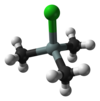Chlorotrimethylsilane
 |
|||
|
|
|||
| Names | |||
|---|---|---|---|
|
Preferred IUPAC name
Chloro(trimethyl)silane
|
|||
| Other names
Trimethylsilyl chloride
Chlorotrimethylsilane TMSCl Trimethylchlorosilane TMCS |
|||
| Identifiers | |||
|
3D model (JSmol)
|
|||
| ChemSpider | |||
| ECHA InfoCard | 100.000.819 | ||
|
PubChem CID
|
|||
| RTECS number | VV2710000 | ||
|
|||
|
|||
| Properties | |||
| C3H9SiCl | |||
| Molar mass | 108.64 g/mol | ||
| Appearance | Colorless liquid, fumes in moist air | ||
| Density | 0.856 g/cm3, liquid | ||
| Melting point | −40 °C (−40 °F; 233 K) | ||
| Boiling point | 57 °C (135 °F; 330 K) | ||
| reacts | |||
| -77.36·10−6 cm3/mol | |||
| Structure | |||
| tetrahedral at Si | |||
| Hazards | |||
|
EU classification (DSD) (outdated)
|
Flammable (F) Corrosive (C) |
||
| R-phrases (outdated) | R11, R14, R20, R21, R35, R37 | ||
| S-phrases (outdated) | S16, S26, S36, S37, S39, S45 | ||
| NFPA 704 | |||
| Flash point | −28 °C (−18 °F; 245 K) | ||
| 400 °C (752 °F; 673 K) | |||
| Related compounds | |||
|
Related halosilanes
|
Trimethylsilyl fluoride Trimethylsilyl bromide Trimethylsilyl iodide |
||
|
Except where otherwise noted, data are given for materials in their standard state (at 25 °C [77 °F], 100 kPa).
|
|||
|
|
|||
| Infobox references | |||
Trimethylsilyl chloride, also known as chlorotrimethylsilane is an organosilicon compound (silyl halide), with the formula (CH3)3SiCl, often abbreviated Me3SiCl or TMSCl. It is a colourless volatile liquid that is stable in the absence of water. It is widely used in organic chemistry.
TMSCl is prepared on a large scale by the Direct process, the reaction of methyl chloride with a silicon-copper alloy. The principal target of this process is dimethyldichlorosilane, but substantial amounts of the trimethyl and monomethyl products are also obtained. The relevant reactions are (Me = CH3):
Typically about 2-4% of the product stream is the monochloride, which forms an azeotrope with MeSiCl3.
TMSCl is reactive toward nucleophiles, resulting in the replacement of the chloride. In a characteristic reaction of TMSCl, the nucleophile is water, resulting in hydrolysis to give the hexamethyldisiloxane:
The related reaction of trimethylsilyl chloride with alcohols can be exploited to produce anhydrous solutions of hydrochloric acid in alcohols, which find use in the mild synthesis of esters from carboxylic acids and nitriles as well as, acetals from ketones. Similarly, trimethylsilyl chloride is also used to silanize laboratory glassware, making the surfaces more lipophilic.
By the process of silylation, polar functional groups such as alcohols and amines readily undergo reaction with trimethylsilyl chloride, giving trimethylsilyl ethers and trimethylsilyl amines. These new groups "protect" the original functional group by removing the labile protons and decreasing the basicity of the heteroatom. The lability of the Me3Si-O and Me3Si-N groups can later be removed ("deprotected"). Trimethylsilylation can also be used to increase the volatility of a compound, enabling gas chromatography of normally nonvolatile substances such as glucose. Trimethylsilyl chloride also reacts with metal acetylides to give trimethylsilyl alkynes such as bis(trimethylsilyl)acetylene. Such derivatives are useful protected forms of alkynes.
...
Wikipedia



